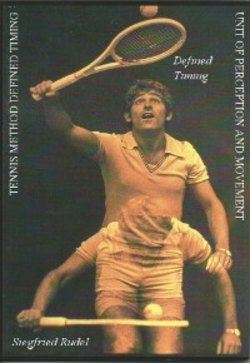Читать книгу Tennis Method - Defined Timing - Siegfried Rudel - Страница 12
1.6 Freedom and compulsion
ОглавлениеThe different approach is made clear by d~veloping the success of a movement by means of the contact-face form movement of racket face and ball and not by seeking the solution by means of a phenographic movement description. While the phenographic approach is based on the belief in the existence of 'the movement' and the 'required value', our approach regards movement only as a possibility. The mov ment form is not determined by the determinism of a kybernetic system, but by the person's freedom in a situation which he is responsible for and which he nust react to. In doing so, the contact-face form movement, which must be learned, at first sight appears to be an unnatural compulsion, a compulsive movement between racket face and ball. Between racket face and ball a mathematical-physical relation is established, and straight lines, parabolas and gravitation are used in order to make the description more precise. This clearness regarding the phenographic form in connection with the purpose of the movement, namely to hit the ball correctly, corresponds to an exactly defined idea as far as perception is concerned. Movement terms such as 'keeping contact', 'guiding', 'opening', 'closing' can be described by physical terms such as circle, straight line, parabola, curve and pendulum.
Figure 7 : Groundstroke - 'Guiding'
In reality, however, the compulsive movement is only the ambiguous side of freedom. The freedom of making the decision to achieve a definite goal has to be paid with the sacrifice of the variety of possibilities, i.e., the player must make a decision. After having chosen, he is submitted to the laws of one possibility. In this context, Christian (1963) speaks of the turning-to, which at the same time is an act of assessment, as something typically human.
If the ball must be placed into a large target area, the racket face can move only very uncontrolled (in an unstructured way). If the small target area, however, is hit well (series), the face movement gets more precise in order to guide the ball (figures 7, 8). If the distance and the height of the ball curve are established in advance, if: forward and backward spin (modulation) are additionally reguired, if the conditions of ball expectation and the actions of the partner involved are taken account of, then the movement of the racket face, which at the moment of hitting must have the corresponding strength momentum, gets more and more definite.
The coincidental form between ball and racket face, the parallelism between perception and movement - offers the possibility to describe the process as a psycho-physical interrelation, which takes account of the axiological character, the purpose of the movement (cf. Christian 1963).
The mathematical-physicaI relation between the movement of the racket face and the ball in connection with the purpose af the movement to hit the ball correctly and to place it makes possible the description of a space-time-structure, the timing of the movement. This structure is characterised by goal, expectancy, speach and action and opens up possibilities of movement learning unthought of-
This learning of movement must take account of the definiteness of a mathematical-physica1 terminology as well as of the realisation of the perception which takes place simultaneously.
Thus, the seeming contradiction between freedom and compulsion resolves itself in the form.
Figure 8 : Half-volley - 'Guiding'
Figure 9 : Throwing' - 'Catching'
